PEOPLE OF ACTION

THE RENAISSANCE AND REFORMATION
(1400 to Mid-1600s)
CONTENTS
(The dates given below indicate the
time frame
of the rule or active influence of these individuals)
 Renaissance
Italy (1400 to Early 1500s) Renaissance
Italy (1400 to Early 1500s)
 The
Holy Roman Empire (during the The
Holy Roman Empire (during the
Renaissance)
 Portugal
and Spain Portugal
and Spain
 France France
 England
and Scotland England
and Scotland
 The
Netherlands The
Netherlands
 Northern
Germany and Scandinavia Northern
Germany and Scandinavia
 The
Holy Roman Empire (during the 1600s) and The
Holy Roman Empire (during the 1600s) and
Southern Germany
 Poland
Poland
 Russia Russia
 The
Ottoman Empire The
Ottoman Empire
 A
Breed Apart: Explorers and Conquerors A
Breed Apart: Explorers and Conquerors
(1500s)
 The
North American Colonies (1600s) The
North American Colonies (1600s)
 The Renaissance
and Reformation: A Full The Renaissance
and Reformation: A Full
History
|
RENAISSANCE
ITALY
(1400 to Early
1500s) |
Pope Martin V
(1417-1431)
Francesco Sforza
( -1466)
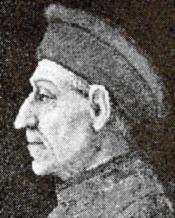 Cosimo
de Medici (1389-1464) Cosimo
de Medici (1389-1464)
Florentine banker and politician.
The Academy of Florence was founded in the second half of the 1400s by
the financial support of Cosimo de Medici (the Academy involved a
very distinct Neo-Platonist departure from the scholastic universities).
He also spent vast sums of money collecting manuscripts and building libraries
to house them.
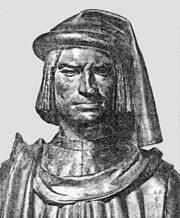 Lorenzo de Medici (1449-1492)
Lorenzo de Medici (1449-1492)
"Lorenzo the Magnificent" |
|
 Prince
Henry ("the Navigator") of Portugal (1394-1460) Prince
Henry ("the Navigator") of Portugal (1394-1460)
John II of Portugal
(1481-1495)
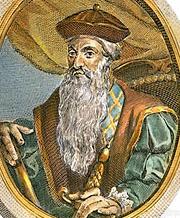 Afonso
de Albuqerque Afonso
de Albuqerque
1453-1515. Builder of Portugal's
Eastern Empire.
Manuel I (1495-1521)
Portuguese King: 1495 to 1521
Isabella of Castile
(1474-1504)
1451-1504. Queen of Castile, 1474-1504.
Wife of Ferdinand of Aragon and joint ruler with him of Aragon, 1479-1504.
Ferdinand II of
Aragon (1468-1516)
1452-1516. King of Spain, 1506-1516.
King of Aragon, 1479-1516. Husband of Isabela and joint ruler with
her of Castile, 1474-1504. Also King of Sicily, 1468-1516 and King
of Naples, 1504-1516.
](../pics/charles-v.jpg) Charles
I of Spain (Charles V of the Holy Roman Empire) (1516-1556) Charles
I of Spain (Charles V of the Holy Roman Empire) (1516-1556)
1500-1558. King of Spain, 1516-1556.
Holy Roman Emperor as Charles V, 1519-1556
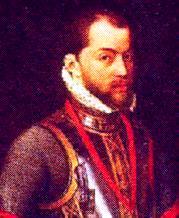 Philip
II (1556-1598) Philip
II (1556-1598)
1527-1598.
King of Spain, 1556-1598.
Husband of Mary
I ("Bloody Mary"), Queen of England
Margaret of Parma
(1559-1567)
1522-1586.
Known also as Margaret of Austria.
She was the illegitimate daughter of Holy Roman Emperor Charles V (Charles
I of Spain) who married Ottavio Farnese, Duke of Parma and Piacenza (1547-1586),
thus becoming Margaret of Parma.
In 1559 she was appointed Regent
of the Spanish Netherlands by her half-brother Philip II – at a time in
which Catholic-Protestant tensions were mounting. When her rather
moderate policy of conciliation between the two factions appeared to be
breaking down, Philip sent the Spanish General, the Duke of Alba, to suppress
the Protestants and to restore the Netherlands to a fully Catholic order.
Alba's subsequent assumption of dictatorial powers led her to resign her
position in 1567.
In 1580 she returned to the Spanish
Netherlands to head up the civil government – under her son, Alexander
Farnese of Parma, governor-general of the Spanish Netherlands.
Relations between mother and son however proved not to be smooth and in
1583 she retired to Italy.
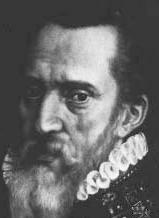 Fernando
Alvarez, Duke of Alva (or Alba) (1567-1573) Fernando
Alvarez, Duke of Alva (or Alba) (1567-1573)
1507-1582.
Governor-General of the Spanish Netherlands,
1567-1573.
Alexander Farnese
of Parma (1578-1592)
Governor of the Spanish Netherlands,
1578-1592.
He was born of an influential Italian
military family (his mother was
Margaret of
Parma, regent of the Spanish Netherlands) and took up soldiering, distinguishing
himself early: against the Turks at Lepanto (1571) and in various
battles against the Protestants in the Spanish Netherlands. He rose
quickly in influence within the Habsburg court and in 1578 was given the
governorship of the Netherlands.
He proved to be a capable Catholic
adversary against the Protestant leader, William of Orange. He succeeded
in holding the southern provinces for Roman Catholicism and in crushing
Protestantism in the key southern cities of Maastricht, Tournai, Brussels,
Ypres, Ghent, Bruges and most importantly, Antwerp (together constituting
today's Belgium).
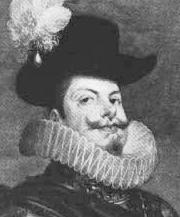 Philip
III (1598-1621) Philip
III (1598-1621)
Philip was only twenty when he came
to the Spainish throne upon his father's death. But he lacked the
strong qualities of his father, including his father's disciplined intelligence – and
was noted more for his laziness and pleaure-seeking ways.
During his 23-year rule, Spain began
its rapid political and economic decline.
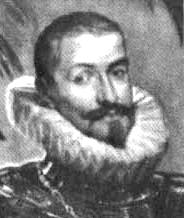 Francisco
Gomes de Sandoval y Rojas, Duke of Lerma (1598-1618) Francisco
Gomes de Sandoval y Rojas, Duke of Lerma (1598-1618)
Born in 1552; died in 1621.
Chief minister under Philip III – and
considered to have been the real ruler of Spain until his political downfall
in 1618.
Philip II had borrowed against all
the future tax revenues of the Spanish monarchy in order to pursue his
aggressive military policy as defender of the Catholic faith throughout
Europe. Thus as Philip III's first minister (beginning in 1598),
Lerma had to tackle the matter of repaying huge debts in such a way as
to leave revenue for the monarchy. He did this by debasing the currency – which
had the unfortunate side effect of chasing silver out of Spain.
But he did put an end to Spain's ceaseless warring policies, which helped
somewhat to relieve economic pressures on Spain.
But perhaps Lerma is best remembered
for his move to expell the Moriscos (Muslims forced into conversion
to Christianity) from Spain. He (and much of Catholic Spain at that
time) considered the Moriscos to be potential support for Spain's hated
enemy, the Turks. Thus in 1609, under Lerma's orders, the remaining
300,000 Moriscos in Spain were shipped off to Morocco – impoverishing the
Moriscos, but also draining Spain of some of its most capable entrepreneurship.
Indeed the loss of the Moriscos brought economic collapse to parts of Spain.
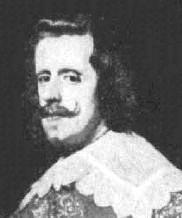 Philip
IV (1621-1665) Philip
IV (1621-1665)
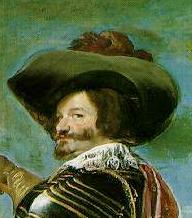 Gaspar
de Guzman, Count-Duke of Olivares (1621-1643) Gaspar
de Guzman, Count-Duke of Olivares (1621-1643)
Olivares was born in Rome in 1587 to
Spanish nobility. Philip III appointed him as part of the household
of his son, Philip IV. When Philip IV came to the throne in 1621,
Olivares became Spain's first minister.
As such he worked hard to try to
bring sound management back to the Spanish empire. Spain was undergoing
obvious rapid political and economic decline. Olivares pursued an aggressive
foreign policy designed to promote the Roman Catholic interests of the
Spanish throne during the religious wars. He also tried to get the
rest of the Spanish dominions to contribute to the costs of maintaining
the Spanish government – in the hopes of relieving Castile of the ruinous
financial burden that had been long laid at its feet. But this tended
only to make the provinces, such as Portugal and Catalonia, all the more
desirous of breaking free of their ties to the Spanish monarchy.
The revolt of those two provinces
in 1640 were the ultimate cause of his fall from power in 1643. He
lived in constant fear of arrest by his political opponents, but died a
natural death in 1645. |
|
Frederick III
(1440-1493)
Maximilian I (1493-1519)
](../pics/charles-v.jpg) Charles
V (1519-1556) Charles
V (1519-1556)
1500-1558. Also King
of Spain as Charles I
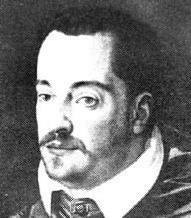 Ferdinand
I (1558-1564) Ferdinand
I (1558-1564)
1503-1564. King of Bohemia and
Hungary, 1526-1564. Emperor, 1558-1564. Brother of Charles
V
|
|
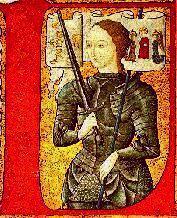 Joan
of Arc (1429-1431) Joan
of Arc (1429-1431)
Joan of Arc was a girl of only
13 when she first heard the voices that would call her to save France from
disintegration. For four years she quietly listened to these voices – until
they became most insistent that she act immediately. By the beginning
of 1429 not only was France widely overrun by the English, but Charles,
the Dauphin of France (heir to the French throne), was rapidly losing authority
within even the portion of France that remained his.
Her reception by French authorities
was about what she expected – total rejection. But she knew the voices
were serious, so she persisted. With the help of some "signs" from
the same voices, she was finally able to convince Charles of the legitimacy
of her call. Finally in April of 1429, given command of a French
army she quickly rounted the English army besieging Orl?ans, chased the
English out of the Loire valley and by July had delivered Reims from the
English so that Charles could be crowned king (Charles VII) in this traditional
coronation site.
But now events began to move against
her. She continued to try to rout the English from France – even though
Charles himself seemed to have little appetite for such doings. When
in September she moved against the English in Paris she was wounded and
the effort failed. Meanwhile Charles made a truce with his enemies
(and England's ally) the Burgundians. But the next spring (1430)
she took up arms again – only to be captured by the Burgundians in an effort
to rally the French at Compi?gne against an English-Burgundian assault
on that town. She was sold by her captor to the English.
She was then turned over to a French
ecclesiastical court (with strong pro-English sentiments) in Rouen to be
tried as a witch. After a lengthy trial she was found guilty of sorcery
and heresy and sentenced to death. On May 30, 1431 she was
burned at the stake as a witch.
Almost immediately it was recognized
that rather than being a witch she had been in fact a true agent of God.
Over the centuries her popularity grew until in 1920 she was canonized
as a saint by Pope Benedict XV.

 Charles
VII (1422-1461) Charles
VII (1422-1461)
Louis XI (1461-1483)
Charles VIII (1483-1498)
Louis XII (1498-1515)
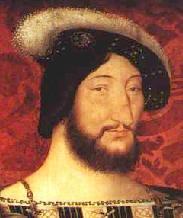 François
(Francis) I (1515-1547) François
(Francis) I (1515-1547)
1494-1547.
Henry II (1547-1559)
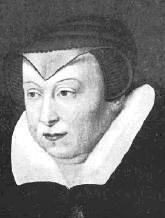 Catherine
de Médicis (1559-1589) Catherine
de Médicis (1559-1589)
1518-1589. Virtual ruler of France,
1559-1589. Queen of Henry II. Mother of Francis II, Charles
IX and Henry III.
Attempted the destruction of all
Protestant Huguenots in France with the Massacre of St. Bartholomew in
1572 (which included the murder of her political nemesis, Admiral Coligny).
Francis Duke of
Guise (1559-1563)
Admiral Coligny
( -1572)
Henry Duke of
Guise ( -1588)
Leader of the
radical Catholic party (the Holy League). Murdered by Henri III at
Blois in 1588.
Henry III ( 1574-1589)
French king whose rule was dominated
by the control of his mother, Catherine de M?dicis.
His attempts to work a compromise between the religious factions and the
dominant political families (the Guises and the Colignys) was continually
undone by his mother's strongly pro-Catholic intrigues.
He was a relatively
frail individual with no heirs – and eventually saw the difficulties that
the end of his reign would bring on France. He thus maneuvered to
swing support behind the legitimate heir to the throne, Henry Bourbon of
Navarre – a leader of the Protestant Huguenot party. To open the way
to this succession he had two of the leaders of the Guise family murdered
in 1588. This was to cause him the extreme hatred of the Catholic
party. He was assassinated in 1589 by a fanatic monk.
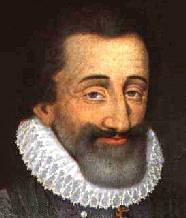 Henry
IV of Navarre (Bourbon) (1589-1610) Henry
IV of Navarre (Bourbon) (1589-1610)
Henry IV of Navarre
(Bourbon). 1553-1610. King of France, 1589-1610.
Early in his career he was a major
leader of the Protestant Huguenot party. For three years after his
accession to the throne of France in 1589, the strongly pro-Catholic Paris
stood in opposition to him. Finally Henry yielded to these stronger
political interests by converting to Catholicism, claiming that Paris was
worth a mass. He also divorced his first wife and married Marie
de Medicis – to further secure his political hold over France.
His rule was directed toward enforced
tolerance between Catholics and Protestants. This gave France a much-needed
period of peace. It also added strength and dignity to the French
monarchy.
Henry was assassinated in 1610.
Sully (Maximilien
de Bethune) (1589-1610)
Marie de Médicis
(1610-1617)
Wife of
Henry IV and Queen Regent of France after his death in 1617 – and until
Louis XIII was old enough to assume rule (1617). During her regency
Cardinal Richelieu was brought to prominence in French politics.
Louis XIII (1617-1643)
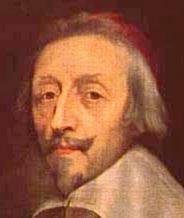 Cardinal
Richelieu (Armand Jean du Plessis de Richelieu) (1614-1642) Cardinal
Richelieu (Armand Jean du Plessis de Richelieu) (1614-1642)
1585-1642. |
|
Henry IV (1399-1413)
Henry V (1413-1422)
Henry VI (1422-1461
/ 1470-1471)
Edward IV (1461-1470
/ 1471-1483)
Edward V (1483)
Richard III (1483-1485)
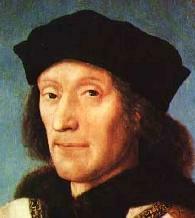 Henry
VII Tudor (1485-1509) Henry
VII Tudor (1485-1509)
1457-1509.
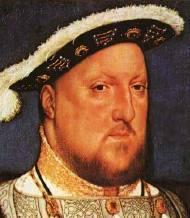 Henry
VIII (1509-1547) Henry
VIII (1509-1547)
1491-1547.
Cardinal Thomas
Wolsey (1503?-1529)
1473-1530. He came to public prominence
as chaplain to Henry VII in the early 1500s. With Henry VII's death
in 1509 Wolsey was appointed to the staff of the young King Henry VIII.
By 1511 he was one of the most important of Henry's counselors.
Thomas Cromwell
(1530-1540)
1485-1540.
Early on in his life, Cromwell was
a bit of an adventurer, then became a lawyer, was profitably involved in
trade, and eventually became a member of Parliament (1523). He served
as legal counsel to the nobility and in 1525 was brought into service as
a lawyer by Cardinal Wolsey. He quickly rose in the Cardinal's favor
because of his sharp legal mind.
When his political mentor Wolsey
fell from power in 1529, Cromwell maneuvered to save himself from destruction
by returning to Parliament and there giving support to King Henry.
Finally in 1530 he was brought into Henry's service – working his way up
in importance until in 1536 he became Lord Privy Seal (main advisor to
the King).
Actually, by 1532 he was already
directing key elements of royal policy – especially in the matter of the
King's relations with Rome. It was Cromwell who pushed the idea of
the King's sovereign power in England even in ecclesiastical matters – literally
excluding the Pope from any further involvement in England's religious
affairs (the Act of Supremacy, 1533). Likewise he was the one who
pushed for an end of traditional monetary support of the Roman Curia.
In 1535 he began the policy of putting
the English monasteries under Royal scrutiny for possible abuses, of using
such abuses then as the rationale for confiscating the enormous wealth
of various monasteries, and of closing them down and selling the land to
wealthy Englishmen (merchants and traders) who had hopes of becoming landed
gentry and thus part of a new nobility. From 1537 to 1540 this process
continued to move forward until the monastic wealth of all England was
entirely confiscated and all the monasteries shut down and sold.
So influential was he in shaping
the political independence of the English crown that in many respects by
1533 he was directing the political affairs of the nation – a dangerous
position in which to find oneself. He created numerous enemies – especially
of the older nobility who resented his having created a whole new nobility
that was wealthier and more powerful than they.
Cromwell also had an eye on religious
developments within England. This was the time of the outbreak of
the Protestant Reformation – and Cromwell, who seemed not to have strong
preferments on the subject personally, nonetheless tended to maneuver the
monarchy in the Protestant direction because he felt that it strengthened
Henry's position. Nonetheless his cool strategizing did not sit well
with the King who had strong Catholic instincts – even though they clearly
contradicted everything he did and stood for. When in 1539 Cromwell
attempted to consummate a political alliance with the Lutheran princes
of Germany, the king balked. Cromwell's enemies saw their opportunity
to undermine his position by drawing the King into the signing of the Six
Articles, which made Protestantism a defacto crime.
Cromwell then maneuvered to restore
his policy and his personal position in the court in that same year by
convincing the King to accept (sight-unseen) a Protestant noblewoman from
Flanders, Anne of Cleves as his fourth wife. When Henry, who placed
much greater emphasis on the allure of the feminine sex than did Cromwell,
realized that Cromwell had married him off to a woman of no beauty at all,
he exploded. Besides, by early 1540 it was apparent that the political
alliance Cromwell had hoped for was proving to be worthless.
Thus Cromwell's career came to an
end. In mid 1540 he was charged with a number of counts of heresy
and treason, was offered no trial and a month later was beheaded.
With the end of Cromwell, Henry's
policies grew confused and chaotic. Indeed, Henry soon regretted
his hasty execution of Cromwell. Cromwell had clearly undergirded
the monarchy with prerogatives and powers it had never enjoyed during the
middle ages. He had been a key player in developing the "modern"
English monarchy and state.
Edward VI (1547-1553)
Somerset (Edward
Seymour)
During the brief reign of Henry's young
son, Edward VI, effective power was first held by the Duke of Somerset,
who plotted a tolerant middle course between Catholicism and Protestantism.
But Somerset could not hold the hostile parties to peace – and lost his
position, and soon thereafter his life.
John Dudley, Duke
of Northumberland (Warwick)
Regent - 1547 to 1553
Somerset's place was taken by Warwick
(Northumberland) who pursued a more aggressive pro-Protestant policy.
But he overplayed his hand – and at the death of young Edward VI, Northumberland
himself lost his own life.
Archbishop Cranmer
(1533-1556)
First Protestant Archbishop of Canterbury,
1533-1556.
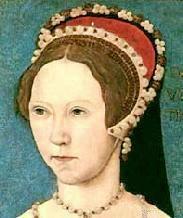 Mary
I (1553-1558) Mary
I (1553-1558)
As a child,
Mary was pledged in marriage to various ruling figures of the day according
to the shift in political opportunity. At one point she was
pledged to her cousin Charles V, Holy Roman Emperor and Spanish King – and
then later to the son of Francis I of France, and even at one point to
Francis himself. But when her father divorced her mother, Catherine
of Aragon, in order to marry Anne Boleyn, her father placed upon Mary the
status of "illegitimate" child. She suffered tremendously, fearing
death at the hands of Anne Boleyn, until Anne herself came under the same
hand by Henry.
Mary looked to her cousin Charles
and to the pope to protect her. Her religious loyalties consequently
became a paramount matter for her. She was devoutly Roman Catholic.
When she came to the throne upon
her half-brother Edward's death, she tried to restore the Catholic church
in England – at least politically, if not economically. But the Pope
would not cooperate with her unless she pledged to return the Church's
lands – which she could not do.
To secure her position, and that
of the Catholic church, she married Philip II, son of her cousin Charles,
who was in line soon to inherit rule over all-powerful Spain. This
threatened to bring England into the Spanish Hapsburg holdings as a mere
province. Furthermore, when this marriage began to drag England unwillingly
into some of Philip's European wars, many of the English became outraged.
Then Mary made a move to kill off
the most influential of her Protestant opponents at home, such as Thomas
Cranmer, Nicholas Ridley and Hugh Latimer (and several hundred others) – earning
her the title "Bloody Mary." She also attempted to undermine the
industrial and commercial wealth of the new nobility by placing various
restrictions on their operations. She cowed the Protestants – but
at the same time heightened their sense of outrage against Catholicism.
Never a very healthy person, Mary
died of a disease after only a quite short rule of five years.
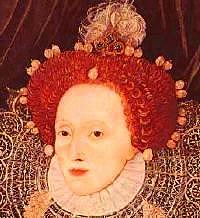 Elizabeth
I (1558-1603) Elizabeth
I (1558-1603)
1533-1603. Daughter of Henry VIII
and Anne Boleyn.
 William
Cecil William
Cecil
William Cecil, Lord Burghley
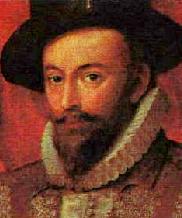 Walter
Raleigh Walter
Raleigh
1552- .
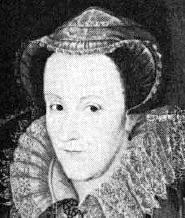 Mary
Stuart, Queen of Scots ( -1587) Mary
Stuart, Queen of Scots ( -1587)
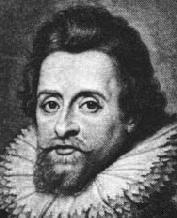 James
I Stuart (1603-1625) James
I Stuart (1603-1625)
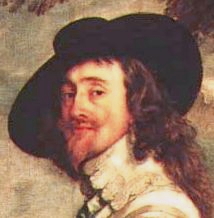 Charles
I (1625-1649) Charles
I (1625-1649)
Beheaded in January of 1649.
 George
Villiers, Duke of Buckingham George
Villiers, Duke of Buckingham
Royal counselor
or adviser, first to James I and then to Charles I.
Thomas Wentworth,
Earl of Strafford ( -1641)
Royal Adviser - 1628-1641
William Laud,
Archbishop of Canterbury (1633-1645)
Archbishop Laud
attempted to rebuild the hierarchical church – working closely with royal
authority to relocated power at England's traditional political center
of monarchical and episcopalian (bishop) authority. In this he was fiercely
opposed by the democratic-minded Puritans – who viewed Laud's reforms as
a return to Catholic popery.
Laud used his
position to attack the Puritans – even cruelly at times. He tried to crush
Presbyterianism (close cousin to Puritanism) in Scotland – starting up the
"Bishops' Wars." He tried to eliminate the most radical of the Puritan
leaders, such as William Prynne – whom he mutilated and brought to trial
for treason. But the net effect was to distance himself from the
English people that he had hoped to win back to more "traditional" church
ways.
Laud's efforts
backfired and in 1640 he found himself arrested by Parliament and led off
to the Tower of London – where he remained until his trial in 1644.
He was beheaded early the following year (1645).
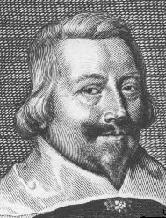 John
Pym (1585-1643) John
Pym (1585-1643) |
|
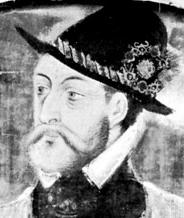 Egmont
(or Egmond), Lamoraal, graaf van Egmont
(or Egmond), Lamoraal, graaf van
1522-1568.
(Unintended) martyr in the Duch Protestant
resistance against Spanish Catholic authority in the Netherlands.
Originally he had been a leading
Dutch nobleman and advisor for Charles, Spanish King and Holy Roman Emperor – helping
direct the Habsburg victories against the French at St Quentin (1557) and
Gravelines (1558) and representing the Spanish crown in the negotiations
leading to the marriage of Charles's Son Philip and Mary I, Queen of England.
Tensions began to arise between Egmont
and Philip (now Spanish King as Philip II) over the continual loss of
local authority as the Spanish crown took direct control over Dutch political
and religious affairs. With the crown's appointment of Cardinal Granvelle
as ruler of the Netherlands Egmont (along with William, Prince of Orange
and Filips van Montmorency, Duke of Horn) successfully petioned for Grenvelle's
removal. But Philip still ignored Dutch protests and instituted an
ever heavier hand against the Protestants in the Netherlands. In
1565 Egmont, William and Horn subsequently withdrew from the Council of
State in protest. Nonetheless Egmont had no desire to be linked with
the Protestant party – and even himself took stern action against Calvinist
insurgency in Flanders.
Indeed, when in 1567 Alva was commisioned
by Philip to crush the Dutch Protestant rebellion against Spanish Catholic
authority, Egmont refused to join the opposition party led by William of
Orange. Even when William turned to German Protestants for assistance,
Egmont confirmed his loyalty to the Spanish government under Margaret of
Parma.
Surprisingly Egmont was arrested
by Alva upon the latter's arrival in the Netherlands – and despite appeals
on his behalf by other noblemen, Egmont was beheaded in 1568 as a
traitor to the Spanish cause. He thus became a widely acclained martyr
in the cause of religious and political freedom for the Netherlands.
Horn (or Hoorne),
Filips van Montmorency, graaf van (1546-1568)
1524-1568.
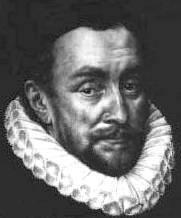 William
I of Orange ("the Silent") (1565-1584) William
I of Orange ("the Silent") (1565-1584)
1533-1584.
Leader of the
Dutch Protestant Cause against Philip II royal absolutism and the Duke
of Alva's predatory military efforts to restore the Netherlands fully to
Catholicism.
Maurice of Orange
(1584-1625)
Frederick Henry
of Orange (1625-1647)
|
NORTHERN
GERMANY AND SCANDINAVIA |
Jacob Fugger (1459-1525)
Frederick III
("the Wise") (1486-1525) Elector of Saxony
1463-1525. Protector of Martin
Luther in the early days of his reformed movement.
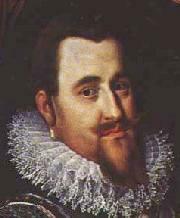 Christian
IV of Denmark Christian
IV of Denmark
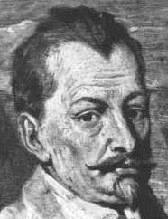 Albrecht
von Wallenstein (or Waldstein) (1618-1634) Albrecht
von Wallenstein (or Waldstein) (1618-1634)
1583-1634.
Bohemian General
at first serving the Holy Roman Emperor Ferdinand II during the 30 Years
War – but whose unlimited amibition caused his alienation from the Emperor
and his death in 1634.
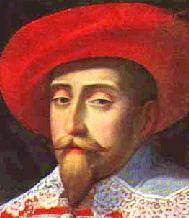 Gustavus
Adolphus of Sweden (1594-1632) Gustavus
Adolphus of Sweden (1594-1632)
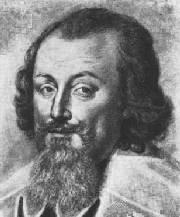 Axel
Oxenstierna Axel
Oxenstierna
Swedish Chancellor.
|
|
|
THE
HOLY ROMAN EMPIRE (DURING THE 1600s) AND SOUTHERN GERMANY |
Rudolph II of
Bohemia (1576 -1612)
1552-1612
Holy Roman Emperor, 1576-1612.
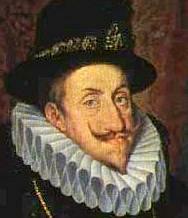 Ferdinand
II (1617-1637) Ferdinand
II (1617-1637)
1578-1637. Holy Roman Emperor,
1620-1637. King of Bohemia, 1617-1637. King of Hungary, 1619-1637.
He acquired the Imperial title just as the Bohemian revolt broke out, starting
the 30 Years' War. Tilly served him ably as general until his death
in 1632. Wallenstein as a general proved to be much more difficult
to direct. Ferdinand's victory in 1635 and the Peace of Prague cost
him the friendship of France.
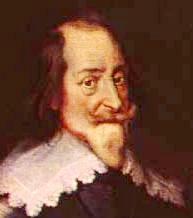 Maximilian
I of Bavaria (1623 -1651) Maximilian
I of Bavaria (1623 -1651)
1573-1651. Duke of Bavaria, 1597-1651,
Elector, 1623-1651).
Founder and leader of the Catholic
League and major supporter of Ferdinand II during the 30 Years' War.
Maximillian demanded of Ferdinand both his lands and electoral title as
the price of his support. His jealousy of Wallenstein proved to be
very damaging to his own interests – and resulted in Bavaria being occupied
at one point by Swedish troops. He was one of the few participants
in the War who successfully survived the struggle. |
|
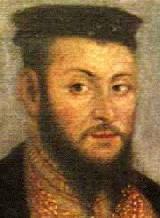 Zygmunt
August (1548-1572) Zygmunt
August (1548-1572)
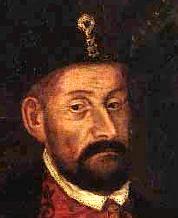 Stefan
Batory (1576-1586) Stefan
Batory (1576-1586)
 Zygmunt
III Vasa (1587-1632) Zygmunt
III Vasa (1587-1632)
King of Poland, 1587-1632. Also
King of Sweden, 1594-1599. As joint Polish-Swedish king, he dearly
wanted to unite Poland with Sweden. But he was forced down from his
Swedish throne in 1599 – an event he never accepted during his lifetime.
In 1609 Zygmunt invaded Russia because
of its weakened monarchy and because of his fear that his Swedish enemies
might make a grab first for Russian power. The ancient town of Smolensk
held out against his attack for nearly two years. In the meantime
in 1610 Moscow fell to his army and his son Wladislaw was declared Russian
Tsar. But nothing lasting came of this enterprise.
He was possessed of a rather dark
personality – and radical Catholic interests.
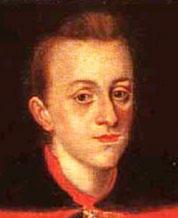 Wladyslaw
IV (1632-1648) Wladyslaw
IV (1632-1648)
Son of Zygmunt III and of a quite different
nature than his father: cheerful and outgoing. However, like
his father, he too wanted to unite the thrones of Poland and Sweden – and
had ambitions in Russia.
Wladyslaw also enjoyed soldiering – though
he was not terribly successful in this regard, in particular against the
Crimean Tatars. His position on the Baltic was not strengthened any
during his rule and the Cossacks in the Ukraine in the southeast remained
for him an unresolved problem in his 16 years of rule.
Jan Casimir (Kazimierz)
(1648-1668)
Brother of Wladyslaw IV and the last
of the Vasas to occupy the Polish throne.
In 1668 he abdicated his throne and
retired to a monastery.
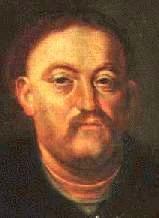 Jan
III Sobieski (1674-1696) Jan
III Sobieski (1674-1696)
Jan Sobieski was elected to the throne
by Polish nobles in 1674. He was a strong ruler, rather focused on
purely Polish interests (having no ambitions in Scandinavia as his predecessors
had) and an able military leader. In 1683 he headed up the coalition
that drove the besieging Turks away from Vienna – a grand victory which
earned him the gratitude of the pope and the Catholic world.
| |
Ivan III ("the
Great") (1462-1505)
Ivan declared independence from Tatar
overlordship in refusing to pay tribute to the Tatars. He conquered
Moscow's rival Russian city Novgorod and thus included along with his title,
Prince of Moscow, the new title of Tsar (Caesar) of Russia.
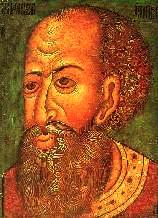 Ivan
IV ("the Terrible") (1547-1584) Ivan
IV ("the Terrible") (1547-1584)
1530-1584. Grandson of Ivan III.
Grand Duke of Russia at age three in 1533. He established his own
absolute authority over the Russian nobles (boyars) – though not without
an incredible amount of conflict (thus his title, "the Terrible").
In concentrating Russian power in his own hands he spared Russia from the
disunity and weakness that characterized her neighbors to the west (Poland
and Germany – where powerful local princes blocked the rise of strong central
authority).
Ivan extended Russian power in Asia
against the Tartars who once ruled them, subduing the Khanates of Kazan
(1552) and Asktrakhan.
Unfortunately Ivan's "terrible" streak
was at times uncontrollable – and in 1581 he killed his oldest son
in a fit of anger.
Fyodor (1584-1598)
Ivan's second son, Fyodor, was of weak
constitution and will. There to fill this power vacuum was his brother-in-law,
Boris Godunov. In 1591 Fyodor's brother Dimitri was murdered – and
Boris Gudunov was suspected, though no action was ever taken against Godunov.
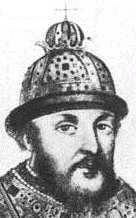 Boris
Godunov (1598-1613) Boris
Godunov (1598-1613)
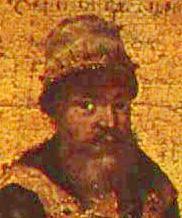 Michael
Romanov (1613-1645 Michael
Romanov (1613-1645
Mehmet I (1413-1421)
Murad II (1421-1444
/ 1446-1451)
 Mehmet
II ("the Conqueror") Mehmet
II ("the Conqueror")
Conqueror of Constantinople in 1453 – ending
the last holdout of the Byzantine Empire.
Bayazid II
Lost Baghdad to the Persians in 1508.
Selim I ("the
Grim") (1512-1520)
Selim extended considerably the land
holdings of the Ottoman Turks. In 1514 he defeated the Persian Shah
Tahmasp at the battle of Chaldiran and seized his capital of Tabriz. and
Cairo in 1517.
S?leyman I ("the
Magnificent") (1520-1566)
Defeated the Hungarians under their
king Louis II at Moh?cs (south of Budapest) in 1526. In 1529 Suleiman
laid seige to Vienna. He also retook Baghdad.
Murad III (1574-95)
Mehmet III (1594-1603)
Cighala-zade Sinan
Pasha
Agha of the Janissaries. Formerly
Scipione Cicala (son of the Viscount di Cicala of Genoa) – captured by the
Turks and forced into Janaissary service. Led the Turks to success
against the Austrians at Mez?-Keresztes in 1596 and at the seige of Erlau.
But he did not fare as well against the Shah Abbas and his Persian army
in 1605.
Ahmet I (1603
to 1617)
Osman II (1618-1622)
Murdered in a palace coup.
 Murad
IV (1623-1640) Murad
IV (1623-1640)
Mehmed IV (1648-1687)
Köprülü Mehmet
Pasha (Grand Vazir: 1656-1661)
Köprülü Fazil
Ahmet Pasha (Grand Vazir: 1661-1676)
Merzifonlu Kara
Mustafa Pasha (Grand Vazir: 1676-1683)
|
|
|
A BREED APART: EXPLORERS AND CONQUERORS
(Early to Mid-1500s) |
|
Marco Polo (1271-1295)
1254?-1324.
As a youth, he set out in 1271 with
his father and uncle, merchants from Venice, on an overland trading mission
to Cathay (China) – arriving there three years later. Young Marco
so impressed the Mongol Emperor of China, Kublai Khan, with his powers
of observation that he was placed in the imperial service as a personal
representative of the emperor, visiting and reporting back to the emperor
on the state of the empire. After 17 years of service in China, the
Polos decided to return to Venice. Along the way home they toured
Persia extensively and finally arrived back in Venice in 1295.
Three years later, serving as a commander
of a Venetian warship, he was captured by the Genoans and held in prison
for about a year. During this idle time he had a fellow prisoner
record his Asian experiences – which on his release was compiled into book
form as The Book of Marco Polo. This work, at first received
as being an exaggeration, was later taken more seriously – and became the
inspiration for later explorers trying to reach the fabled East.
 Polo's
major work or writings: Polo's
major work or writings:
The Book of Marco
Polo
Bartholomeu Dias
(c. 1450-1500)
Portuguese Explorer who in 1488 was
the first to sail around the southern tip of Africa at the Cape of Good
Hope and point the way east to the Indies via the Indian Ocean.
He was lost at sea off the Cape of
Good Hope in 1500 during a naval and commercial mission to India headed
by Pedro Alvares Cabral.
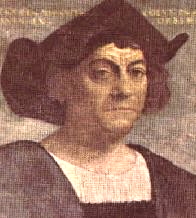 Christopher
Columbus (c. 1446-1506) Christopher
Columbus (c. 1446-1506)Columbus
made four journeys to America. The first
trip (1492-1493) he returned after creating a settlement La Navidad on the huge
island he called Española.
After leaving half his crew there, he was able (through storm and political
problems with the Portuguese) to return to present the King and Queen with a
chest of gold items and some Indian "interpreters."
The second trip
(1493-1496) was undertaken with a huge fleet (17 ships and 1200 men) … but
failed to find any gold, struggled with some of the Indians, and faced a huge rebellion
of his men. He left his brothers in
charge and returned to Spain … with no gold.
The third trip
(1498-1500) was undertaken mostly to block an effort by John of Portugal to match
the Spanish effort. But Columbus found only
chaos upon his arrival at Española. News
of the chaos reached back to Spain … and Francisco de Bobadilla was sent to Española
to clear up the mess. He and Columbus
fought … and Bobadilla sent Columbus back to Spain in chains.
Columbus,
after much pleading was then authorized to undertake a small, fourth trip
(1502-1504). But he was refused entry at
Española when he arrived there. So he
moved, via Cuba and Jamaica, on to the mainland (Honduras, Nicaragua and
Panama). In Panama he discovered his gold
… but also naval disaster and personal sickness. He managed to get back to Jamaica … but
waited for a year for support allowing him to make his return to Spain. He was not received officially on his return
(the Queen was dying) and only belatedly managed to receive his share of the gold
profits. He died a very sick man at age
54 (1506), largely forgotten … though his two books, Book of Privileges (1502)
and Book of Prophecies (1505) would leave some kind of legacy.
John Cabot (c.
1450-1498)
John Cabot was
an Italian explorer who came into service to English King Henry VII.
Like Colombus, he had long been conviced that Asia could be reached by
sailing West. News of Columbus' discovery encouraged Henry to take
up Cabot's proposal to try to reach the East by sailing West. Thus
in 1497 Cabot set out to reach the East for the English king. He
instead encountered North America (possibly Newfoundland or Labrador),
though on his return to England he affirmed that it was northeastern Asia
he had encountered. In any case he brought news of the wealth of
fish and good land for settlement in the land he had encountered.
The following
year, this time with five ships and 200 men, Cabot set out again on the
same journey West. But the details of what then occurred are hazy.
In any case his expedition failed to return to England. As a consequence,
little of lasting value resulted from his efforts.
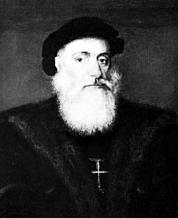 Vasco
da Gama (c. 1460-1524) Vasco
da Gama (c. 1460-1524)
Da Gama was a Portuguese explorer who
first reached India in 1498 by sailing around the southern tip of Africa
at the Cape of Good Hope, continuing up the eastern shores of Africa, and
crossing the Indian ocean from (modern-day) Kenya to Calicut in India.
He sailed for India a second time
in 1502 at the head of a fleet of 20 ships that was charged with punishing
the Zamorin (Muslim ruler) of Calicut for having massacred the Portuguese
left behind in India by another Portuguese explorer, Pedro
Alvares Cabral. Treaties were concluded with neighboring Hindu
enemies of the Zamorin and an effort of an Arab fleet to drive away da
Gama was defeated. In early 1503 da Gama returned with his fleet
to Portugal.
In 1524 he was sent by King John
III to be the Portuguese viceroy in India. He established an administrative
center at Goa and immediately began the process of strengthening
the Portuguese commercial position in India. But he became sick and
died before the year was out.
Pedro Alvares
Cabral (c. 1460-1520)
Cabral was a Portuguese explorer commissioned
by Manuel I to follow up on da Gama's exploration of India in 1498 and
consolidate the Portuguese position in India.
In March of 1500 Cabral left for
India with 13 ships, but headed westward into the Atlantic to sail around
the becalmed waters of Guinea – and discovered the shores of Brazil in the
process. He then headed east for the Cape of Good Hope (where he
lost 4 of his ships and the fellow explorer
Bartolomeu
Dias).
In September he arrived at Calicut
and signed a commercial treaty with the Zamorin (Muslim ruler) permitting
him to establish a fortified trading post at Calicut. But disputes
arose with the Muslim merchants and in December the trading post was attacked
and most of the inhabitants massacred before Cabral could get a rescue
party ashore from the boats offshore. Cabral took revenge by bombarding
the city and capturing 10 Muslim ships – before sailing on to Cochin where
he received a friendlier reception. Here he traded for precious spices.
In early 1501 he set sail for Portugal – but
disasters along the way permitted him to complete the voyage with only
four of the ships he had originally started the expedition with.
Despite his warm reception by the
Portuguese King Manuel, it was de Gama and not Cabral who received the commission
to follow up Cabral's commercial venture with an even grander expedition
in 1502.
Cabral retired from royal service
and lived out his life quietly on his rural estates until his death in
1520.
Juan Ponce de
Leon (c. 1460-1521)
A Spanish nobleman-soldier who was appointed
governor of the eastern portion of the island of Hispañola. Stories
of gold to be found on the adjoining island (Puerto Rico) led him to explore
and settle the first Spanish settlement on that island (near present-day
San Juan) in 1508-1509. He was appointed briefly as governor of that
island – until political intrigue led to his removal from that position.
But he was not to be pushed aside
and he was soon off exploring to the north in pursuit of a story about
a fountain that could restore a person's youth. This brought him
in early 1513 to the Bahamas and to Florida (which he first supposed was
also an island – until he started sailing south along its coast and discovered
its true extent). He returned to Spain in 1514 and had himself confirmed
by the King as Governor of Bimini and Florida. He returned to Florida
in 1521 with 200 men, with the intent of establishing a Spanish colony
there. But upon his arrival he was hit by a Seminole arrow and died
soon thereafter in Cuba.
Vasco Nuñez de
Balboa (c. 1475-1517)
Balboa was of a lesser noble family
and sought his fortune in Spanish America, coming to the colony in 1500.
At first he was part of a Spanish exploration party along the Caribbean
coast of modern-day Colombia; then he attempted farming (unsuccesfully)
in Hispañola. He fled from his mounting debts by returning to Colombia
with a party of settlers. This time Balboa distinguished himself
as a leader by building the foundations of a lasting settlement there.
In 1511 King Ferdinand II confirmed Balboa's position by naming him governor
of the entire region of Darién.
Rumors of much gold to the South
(undoubtedly in reference to the wealth of the Incas of Peru) led
Balboa to try to form an exploration party of his own. But court
intrigue back in Spain had turned the King against him and Balboa was not
only left behind, his command in Darién was given to a Spanish nobleman,
Pedro Arias Dávila (known as "Pedrarias").
Not willing to await his demotion,
Balboa set out across Darién and thus discovered the vast Pacific Ocean
across the lower Panamanian isthmus to the West. He claimed this
South Sea for Spain – and sent news of this discovery to Spain. Ferdinand
confirmed Balboa's right of discovery by naming him governor of the South
Sea – but still placed him beneath Pedrarias' authority.
The rivalry of Balboa and Pedrarias
was intense, though over time court opinion in Spain began to favor Balboa.
Pedrarias, realizing that his rival was gaining ascendancy, thus wooed
Balboa to a supposedly friendly meeting and there arrested him and had
him put to death.
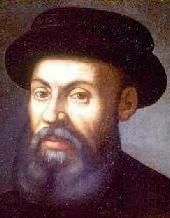 Ferdinand
Magellan (c. 1480-1521) Ferdinand
Magellan (c. 1480-1521)
Magellan was born in Sabrosa of Portuguese
nobility – though in his late thirties he renounced his Portuguese citizenship
and came into service to the Spanish King Charles I. It was to Charles
that he announced his idea of avoiding the well- entrenched Portuguese
positions along the route to the East Indies – by sailing west from
Spain across the Atlantic and continuing in that direction (by-passing
the Americas) until he arrived at the Indies from the East! He received
Charles' support and on September 20, 1519, he set sail from Sanlúcar de
Barrameda with five ships.
He crossed the Atlantic and in November
arrived at modern-day Argentina, exploring the Rio de la Plata and coming
ashore for the winter at Patagonia.
Late the next spring he then continued
southward around the storm-tossed and rocky straits off the southern tip
of South America (the "Straits of Magellan") – taking 38 days to make that
dangerous passage – and then headed westward across the Pacific. He
arrived at the Marianas. He then continued on to the Philippines – arriving
there in March of 1521.
Ever the nobleman, he got himself
involved in a political alliance with the ruler of Cebu island – and joining
his Spanish forces with his ally's he launched an attack on the Mactan
islanders – and was killed in the process.
His fleet, or what was left of it,
arrived at the Moluccas on November 6, 1521. The sole ship to survive
the entire voyage, the Victoria, commanded by Juan Sebastión del
Cano, finally arrived at Seville on September 6, 1522.
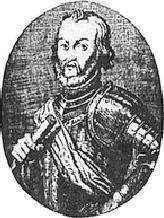 Hernando
Cortés (1485-1547) Hernando
Cortés (1485-1547)
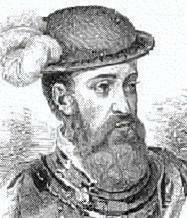 Francisco
Pizarro (c. 1470-1541) Francisco
Pizarro (c. 1470-1541)
He was a Spanish explorer who, as the
newly appointed governor of Spanish Peru, conquered the Incan Empire in
1533 – and opened up the fabulous Incan wealth to Spanish plunder.
Two years later, in 1535, he founded Lima and made it his Peruvian capital.
Sebastian Cabot
(c. 1474-1557)
Jacques Cartier
(1491-1557)
Hernando De Soto
(c. 1500-1542)
Francis Drake
(c. 1540-1596)
Henry Hudson (
-1611?)
|
|
THE
NORTH AMERICAN COLONIES |
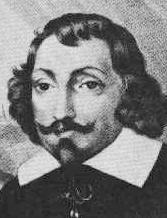 Samuel
de Champlain (1603-1635) Samuel
de Champlain (1603-1635)
1567?-1635.
French explorer and founder of a
fortified settlement at Quebec (1608).
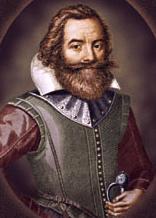 John
Smith (1607-1609) John
Smith (1607-1609)
1580?-1631.
Smith was the
principle organizer of the first successful English colony in North America
(Virginia) at Jamestown in 1607.
 Smith's
major works or writings: Smith's
major works or writings:
Map
of Virginia with a Description of the Country (1612)
The
generall Historie of Virginia, New England, and the Summer Isles
(1624)
A Description
of New England (1625)
The
True Travels, Adventures and Observations of Captaine John Smith
in Europe, Asia, Africa and America (1630).
William Bradford
(1621-1656)
1590-1657.
One of the Separatists from the Church
of England who as a "pilgrim" sailed to America from Holland in 1620 on
the Mayflower – to settle the new Plymouth colony in Massachussetts.
In recognition of his excellent organizing skills he was elected Governor
of the Plymouth Colony in 1621, and annually all but 5 years thereafter
until 1656.
 Bradford's
major work or writings: Bradford's
major work or writings:
History of Plymouth
Plantation, 1620-47
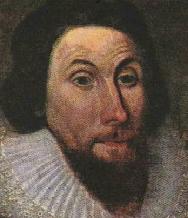 John
Winthrop (1630-1649) John
Winthrop (1630-1649)
1588-1649.
Founder of Boston and governor or
deputy governor of the Massachussetts Bay Company, 1637-1649.
Roger Williams
(1636-1683)
1603-1683.
Founder of the Providence/Rhode Island
Colony in 1636 – after having been expelled from the Massachussetts Bay
Colony for the heresy of preaching against the close connection of the
church and the Massachussets government and for his criticism of the Bay
Colony's unjust treatment of the Indians.
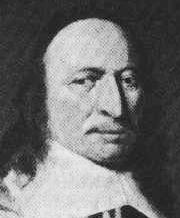 Peter
Stuyvesant (1647-1664) Peter
Stuyvesant (1647-1664)
1592-1672.
|
THE RENAISSANCE
AND REFORMATION:
A FULL HISTORY |
 Miles
H. Hodges Miles
H. Hodges
| |





 Cosimo
de Medici (1389-1464)
Cosimo
de Medici (1389-1464)
 Prince
Henry ("the Navigator") of Portugal (1394-1460)
Prince
Henry ("the Navigator") of Portugal (1394-1460) Afonso
de Albuqerque
Afonso
de Albuqerque](../pics/charles-v.jpg) Charles
I of Spain (Charles V of the Holy Roman Empire) (1516-1556)
Charles
I of Spain (Charles V of the Holy Roman Empire) (1516-1556) Philip
II (1556-1598)
Philip
II (1556-1598) Fernando
Alvarez, Duke of Alva (or Alba) (1567-1573)
Fernando
Alvarez, Duke of Alva (or Alba) (1567-1573) Philip
III (1598-1621)
Philip
III (1598-1621) Francisco
Gomes de Sandoval y Rojas, Duke of Lerma (1598-1618)
Francisco
Gomes de Sandoval y Rojas, Duke of Lerma (1598-1618) Philip
IV (1621-1665)
Philip
IV (1621-1665)
 Ferdinand
I (1558-1564)
Ferdinand
I (1558-1564) Joan
of Arc (1429-1431)
Joan
of Arc (1429-1431)
 Charles
VII (1422-1461)
Charles
VII (1422-1461) François
(Francis) I (1515-1547)
François
(Francis) I (1515-1547) Catherine
de Médicis (1559-1589)
Catherine
de Médicis (1559-1589) Henry
IV of Navarre (Bourbon) (1589-1610)
Henry
IV of Navarre (Bourbon) (1589-1610) Cardinal
Richelieu (Armand Jean du Plessis de Richelieu) (1614-1642)
Cardinal
Richelieu (Armand Jean du Plessis de Richelieu) (1614-1642) Henry
VII Tudor (1485-1509)
Henry
VII Tudor (1485-1509) Henry
VIII (1509-1547)
Henry
VIII (1509-1547) Mary
I (1553-1558)
Mary
I (1553-1558) Elizabeth
I (1558-1603)
Elizabeth
I (1558-1603) William
Cecil
William
Cecil Walter
Raleigh
Walter
Raleigh Mary
Stuart, Queen of Scots ( -1587)
Mary
Stuart, Queen of Scots ( -1587) James
I Stuart (1603-1625)
James
I Stuart (1603-1625) Charles
I (1625-1649)
Charles
I (1625-1649) George
Villiers, Duke of Buckingham
George
Villiers, Duke of Buckingham John
Pym (1585-1643)
John
Pym (1585-1643) Egmont
(or Egmond), Lamoraal, graaf van
Egmont
(or Egmond), Lamoraal, graaf van William
I of Orange ("the Silent") (1565-1584)
William
I of Orange ("the Silent") (1565-1584) Christian
IV of Denmark
Christian
IV of Denmark Albrecht
von Wallenstein (or Waldstein) (1618-1634)
Albrecht
von Wallenstein (or Waldstein) (1618-1634) Gustavus
Adolphus of Sweden (1594-1632)
Gustavus
Adolphus of Sweden (1594-1632) Axel
Oxenstierna
Axel
Oxenstierna Ferdinand
II (1617-1637)
Ferdinand
II (1617-1637) Maximilian
I of Bavaria (1623 -1651)
Maximilian
I of Bavaria (1623 -1651) Zygmunt
August (1548-1572)
Zygmunt
August (1548-1572) Stefan
Batory (1576-1586)
Stefan
Batory (1576-1586) Zygmunt
III Vasa (1587-1632)
Zygmunt
III Vasa (1587-1632) Wladyslaw
IV (1632-1648)
Wladyslaw
IV (1632-1648) Jan
III Sobieski (1674-1696)
Jan
III Sobieski (1674-1696) Ivan
IV ("the Terrible") (1547-1584)
Ivan
IV ("the Terrible") (1547-1584) Boris
Godunov (1598-1613)
Boris
Godunov (1598-1613) Michael
Romanov (1613-1645
Michael
Romanov (1613-1645 Mehmet
II ("the Conqueror")
Mehmet
II ("the Conqueror") Murad
IV (1623-1640)
Murad
IV (1623-1640) Christopher
Columbus (c. 1446-1506)
Christopher
Columbus (c. 1446-1506) Vasco
da Gama (c. 1460-1524)
Vasco
da Gama (c. 1460-1524) Ferdinand
Magellan (c. 1480-1521)
Ferdinand
Magellan (c. 1480-1521) Hernando
Cortés (1485-1547)
Hernando
Cortés (1485-1547) Francisco
Pizarro (c. 1470-1541)
Francisco
Pizarro (c. 1470-1541) Samuel
de Champlain (1603-1635)
Samuel
de Champlain (1603-1635) John
Smith (1607-1609)
John
Smith (1607-1609) John
Winthrop (1630-1649)
John
Winthrop (1630-1649) Peter
Stuyvesant (1647-1664)
Peter
Stuyvesant (1647-1664)

